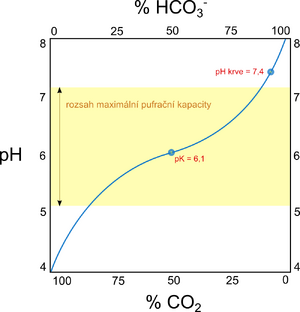Bicarbonate buffer
The "bicarbonate buffer system" (also "bicarbonate") is the most important and effective buffering system in the body. Especially in the blood, where it accounts for up to 53% buffering capacity.[1] Its importance lies in its good ability to maintain a stable pH mainly due to the fact that the concentration of both components can change independently - CO2</ sub> by breathing, HCO3- by kidney and liver activity. Therefore, the bicarbonate buffer in the body is referred to as an open buffering system.
The reaction proceeds as follows: CO2 + H2O HCO3- + H< sup>+.
Buffers composed of weak acids and their salts (or weak bases and their salts) with the same substance concentration have the greatest buffering capacity, i.e., more precisely, for which pH = pKA'. The optimal blood pH value is 7.4' ± 0.04. The pKA value for bicarbonate buffer is 6.1. Thus, it appears that this buffer will not buffer pH fluctuations very well. But the opposite is true. For a better idea, here is an example:
To Henderson-Hasselbalch equation
we substitute physiological concentrations
- HCO3- = 24 mmol/l and CO2 1.2 mmol/l.
- (Ratio of base to acid is therefore 20:1.)
Resulting pH = 7.4 .
In the case of a closed system, after the addition of H+, conjugated acid CO2 is formed, which cannot escape from the system, and thus its concentration rises. An increase in the concentration of CO2 by 2 mmol/l is reciprocally balanced by a decrease in the concentration of HCO3-.
- Resulting pH = 6 ,93. (In this case, the buffering capacity of the buffer is very small, because the value of 6.93 is quite far from 7.4.)
However, if the resulting CO2 is removed (exhaled) from the system, as is the case with the bicarbonate open system, only the concentration changes with the addition of H+ HCO3-. The ratio of HCO3- to CO2, and thus the pH value, will shift much less.
- Resulting pH = 7 ,36.
Summary: An increase in H+ in the blood leads to the production of CO2, which is soon exhaled in the lungs, allowing a constant pCO2< /sub>, i.e. a concentration of 1.2 mmol/l.
Links[edit | edit source]
Related Articles[edit | edit source]
Reference[edit | edit source]
- ↑ FONTÁNA, Josef. Acid-base balance [lecture for subject Biochemistry, specialization General medicine, 3.LF Charles University]. Prague. 30.3.2011.
References[edit | edit source]
- LEDVINA, M. Biochemie pro studující medicíny II. 2. edition. Nakladatelství Karolinum, 2009. 281 pp. ISBN 978-80-246-1415-1.



![{\displaystyle pH=pK_{A}+\log {\frac {[HCO_{3}^{-}]}{[CO_{2}]}}}](https://wikimedia.org/api/rest_v1/media/math/render/svg/80928df498a2075049af80b9666618503495bf74)


